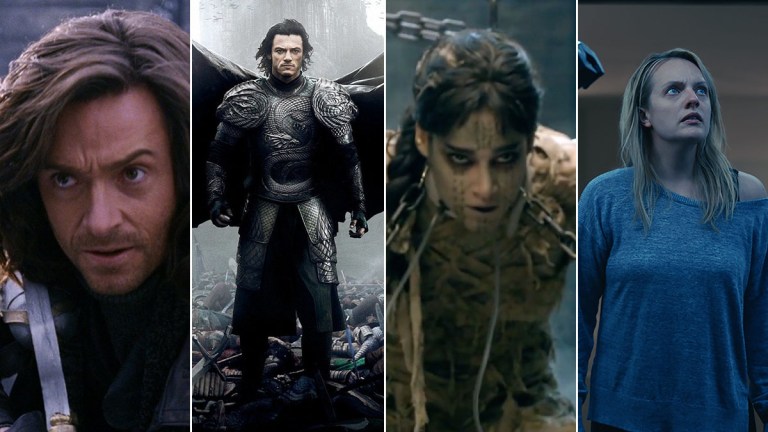Universal Monsters: The Invisible Man Shows Life After Dark Universe Death

Over the last weekend, an eerie thing happened at the box office: Leigh Whannell and Blumhouse Productions’ The Invisible Man brought the Universal Monsters legacy back with a vengeance. Over-performing with a monstrous box office bow of $29 million in the U.S. alone, the horror reimagining of the H.G. Wells novel (and James Whale’s 1933 film) more than quadrupled its $7 million budget in only three days.
This is of course good news about a good horror movie, one of the best in a while with its panic attack-inducing allegory about a woman being gaslighted by an abusive ex. But it’s also rather miraculous news for the Universal Monsters label, which has by and large languished in the 21st century despite multiple attempts to resurrect it from the dead. Indeed, just three years after the Dark Universe was embarrassingly put out to pasture following The Mummy’s disastrous June 2017 debut, the Universal Monsters once again look viable. So of course the question is: Why is that and what lessons can be learned for the future?
An Emphasis on Horror Over Spectacle
One of the key reasons that Whannell and Blumhouse’s The Invisible Man succeeded where many previous Universal Monster revivals stumbled is the Whannell movie leaned heavily into the horror brand—even more so than a number of Blumhouse’s other efforts.
Told as an isolated horror story in a handful of locations, Whannell embraced the horror tropes he helped pioneer at Jason Blum’s home for horror filmmakers. The film includes more than a handful of jump scares and haunted house tricks from the Insidious movies, all of which Whannell helped script (he also directed the third chapter in the series). However, that is just a jumping off point for what makes The Invisible Man work. For it very much adapts Wells’ mad scientist from the 1897 novel, even if he is no longer a Victorian megalomaniac with delusions of conquest. Oliver Jackson-Cohen’s Adrian Griffin is still a megalomaniac (or “malignant narcissist” as Whannell described him to us), but his dreams of domination are solely based around the woman in his life.
The frightening aspects of the Invisible Man character—his cruelty, his perniciousness, and his omnipresent vengefulness—are carried over in a modern context, but one that a modern audience can relate to, thanks in large part to Elisabeth Moss’ extraordinary performance as Cecilia Kass, a woman who knows that her ex has found a way to torture her without ever being seen. She’s also a woman used to being painted as the “crazy one” by both Adrian and a society that never believes her over the protestations of men, especially those as rich and powerful as Adrian.
It is a modern horror through and through, and is strikingly unlike most of Universal’s previous attempts to turn their monsters into whatever the popular blockbuster trends of the day were. To be fair, their first remake of The Mummy in 1999 had major success by emulating the Indiana Jones movies from the prior decade (and for jumping on the CGI bandwagon before the technology would be exhausted by overindulgent mediocrity, including 2001’s The Mummy Returns). But the same approach proved ghastly when applied to Van Helsing (2004), which might have arrived five years too early with its kitchen sink approach of putting Dracula, Frankenstein’s Monster, and The Wolf Man all in the same film. An unintentional precursor to the superhero movie team-ups to come after 2012’s The Avengers, Van Helsing had far too many characters and far too little characterization or depth. It also was another CGI eyesore that hasn’t aged well.
Universal made a similar mistake in 2017 with the ill-fated Dark Universe. Only now the studio was chasing the current fad of shared universes and tried to make The Mummy into a superhero franchise. Literally by the end of the film, Tom Cruise’s Nick Morton has all of Egypt’s deadly plagues as superpowers and is effectively a heroic mummy. This bore little resemblance to why people want to watch a film about ancient Egyptian ghouls, which was crystallized by the film’s disastrous box office, at least when compared to its price tag.
Consider: The Mummy opened at $31 million in 2017. That’s only $2 million more than The Invisible Man. But the latter is a modern day “microbudget” horror movie budgeted at $7 million, and the former was a superhero-wannabe with a reported budget of $125 million.
Straying from the horror roots of these characters will likely continue to be anathema. This was the case for Van Helsing and The Mummy, and it was also the case with 2014’s Dracula Untold, a misbegotten attempt at turning Count Dracula into a Gladiator-styled hero about 10 years too late on that fad. Straying from the horror roots of these characters will likely continue to be anathema. While Universal did embrace a horror aesthetic with The Wolfman (2010), it was with an exceedingly expensive period piece approach that included even pricier reshoots. Its finished budget is estimated to be $150 million. While I dig the old school classicalism of that film, its troubled screenplay and production resulted in a clearly uneven movie. Yet if it had cost a third of its budget, opening at $31 million in 2010 box office dollars might not have been a death sentence.
Conversely, The Invisible Man did follow some modern trends with its Blumhouse-ized reimagining of a horror icon, but never lost sight of what made Adrian Griffin scary. Rather it found a modern reason why we’d want to see him put down.
Standalone Stories Instead of Shared Universes
Another crucial reason for The Invisible Man’s success with both critics and audiences is it tells a complete standalone horror tale. It even eschews the cliché of certain other Blumhouse brands that set-up for a clear sequel (although one is still potentially possible). Noting this in regards to a horror film should go without saying but… one again only needs to look at the ill-fated Dark Universe. As mentioned, 2017’s The Mummy followed the trends of 2017 (a year that also gave us Justice League) and attempted to turn the Universal Monsters into a shared superhero universe.
To be sure, the first shared cinematic universe is the monster mashes Universal produced in the 1940s, beginning with Frankenstein Meets the Wolf Man (1943). Yet that came at the end of an about 15-year cycle of Universal saturating the market with supernatural chillers that were once considered “A-pictures” like Dracula and Frankenstein in 1931, and then became B-movie programmers during the World War II years. There was always an inherently camp and faintly desperate quality to smashing these characters together, and while it can be done in more serious and earnest fashion (as demonstrated by Marvel), beginning at that point is pure folly.
Hence why The Mummy’s cluttered narrative grinds to a halt for about half an hour so a slew of “easter eggs” can be clumsily chucked across the screen. Russell Crowe makes a cameo appearance to mug as the Dark Universe’s own Nick Fury, here called Dr. Jekyll, and his office includes vampire fangs and other meaningless paraphernalia that have no weight when the story it’s being introduced in is such a disaster.
Meanwhile the new Invisible Man tells its story from beginning to end. There is room for a sequel, if one wants it, but for now audiences are simply satisfied with Cecilia’s journey of emancipation from a true monster. And that was before he even went invisible.
A Specialized Approach for Each Monster
So how should one best use the valuable Universal Monster IP going forward? Currently, Universal is playing its plans close to the vest. While The Invisible Man was the first collaboration between the studio and Blumhouse with one of these legacy characters, no other similar projects have been officially announced. In fact, the studio is also concurrently pursuing a musical based on the 1962 pop hit, “Monster Mash,” in which the iconic characters would presumably belt a song or two.
Far be it from us to tell a major corporation how best to implement their brands, but we think rather than leaning into the campy aspect of the characters, The Invisible Man shows a savvy way for what Universal should do with several of the characters going forward. Beyond The Invisible Man, sharp and socially conscious horror with top-tier acting has proven to be in vogue as of late. As demonstrated by Universal and Blumhouse’s previous collaborations with Jordan Peele, Get Out and Us, there is an appetite for horror that may not be as “elevated” as the A24 approach, but is even more lucrative given its mainstream chills with top-notch filmmaking talent willing to dive into loaded social subtexts.
Several characters seem like they could easily work within the Blumhouse wheelhouse, including The Wolf Man and Creature from the Black Lagoon. The former is the most iconic werewolf story and already in its original 1941 film has elements about the relationships between fathers and sons, and the horror of someone you know giving into their demons. While the 2010 movie took a downright Oedipal approach in remaking this concept, a slightly pared down and more natural modern version would be a lot less expensive and a hell of a star vehicle for the right character actor looking for scenery to chew.
Creature, meanwhile, was remade in spirit by Guillermo del Toro into an Oscar winner named The Shape of Water. That film’s success proves the innate flexibility of the title character. So while Universal and Blumhouse are unlikely to do something so Gothic or romantic as del Toro, reimagining the character as a modern myth in the South American rainforest has already been proven viable. Now imagine that scenario in a modern day tale about, say, privileged tourists or deforesters finding themselves in a pocket they should’ve never entered?
But at the end of the day, the characters themselves should provide the solution in how Universal adapts them. Personally, it is harder to imagine literary icons of 19th century England like Dracula, Frankenstein, or the Bride of Frankenstein (who, yes, never came alive in the book) working so well in the Blumhouse style—or a modern setting. Time and again, modernized adaptations of these characters have been underwhelming. Just this year’s BBC and Netflix co-production, Dracula, literally faltered when the third and final episode disappointingly jumped to the 21st century. Tellingly, it was a misstep Universal also made in the final scenes of Dracula Untold.
Honestly, those characters might fit better with the A24 “elevated” approach. We even almost got a Nosferatu remake from Robert Eggers, director of The Witch and The Lighthouse, and, hey, he recently told us it would “be a shame” if he never made it. Yet just as Us and The Invisible Man feel a cut above other of Universal’s allegedly more all-ages friendly horror fare, such as Fantasy Island or Happy Death Day, it is possible to imagine Blumhouse stepping further outside of audience expectation to achieve something truly great—and to do it on a budget.
